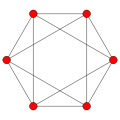Top Qs
Timeline
Chat
Perspective
Antiprism graph
Graph with an antiprism as its skeleton From Wikipedia, the free encyclopedia
Remove ads
In the mathematical field of graph theory, an antiprism graph is a graph that has one of the antiprisms as its skeleton. An n-sided antiprism has 2n vertices and 4n edges. They are regular, polyhedral (and therefore by necessity also 3-vertex-connected, vertex-transitive, and planar graphs), and also Hamiltonian graphs.[1]
Examples
The first graph in the sequence, the tetrahedral graph, has 4 verticies and 6 edges. The second, the octahedral graph, has 6 vertices and 12 edges. Later graphs in the sequence are named after the type of antiprism they correspond to:
- Square antiprismatic graph – 8 vertices, 16 edges
- Pentagonal antiprismatic graph – 10 vertices, 20 edges
- Hexagonal antiprismatic graph – 12 vertices, 24 edges
- Heptagonal antiprismatic graph – 14 vertices, 28 edges
- Octagonal antiprismatic graph – 16 vertices, 32 edges
- ...
 2 |
 3 |
 4 |
 5 |
 6 |
 7 |
 8 |
Although geometrically the star polygons also form the faces of a different sequence of (self-intersecting) antiprisms, the star antiprisms, they do not form a different sequence of graphs.
Remove ads
Related graphs
An antiprism graph is a special case of a circulant graph, Ci2n(2,1).
Other infinite sequences of polyhedral graph formed in a similar way from polyhedra with regular-polygon bases include the prism graphs (graphs of prisms) and wheel graphs (graphs of pyramids). Other vertex-transitive polyhedral graphs include the Archimedean graphs.
References
External links
Wikiwand - on
Seamless Wikipedia browsing. On steroids.
Remove ads